Hurricane Milton hit Florida as a Category 3 storm with 120 mph winds near Siesta Key, causing devastation as it moved eastward. St. Lucie County Sheriff Keith Pearson confirmed the occurrence of 17 tornadoes and multiple fatalities in the area, with ongoing rescue missions and hundreds of homes destroyed.
This destructive landfall followed closely behind Hurricane Helene, which had previously battered Florida before moving on to North Carolina. Residents had been preparing for Milton by boarding up windows and evacuating their homes in anticipation of the storm’s impact.
The National Hurricane Center warned that Milton had the potential to be one of the most damaging hurricanes in west-central Florida’s history. The storm is projected to pass through central Florida and into the Atlantic, with power outages affecting 1.8 million customers and storm surges expected to reach up to 15 feet along the coast.
Florida Governor Ron DeSantis activated thousands of National Guard members for search and rescue efforts post-storm, while President Biden’s administration pre-deployed resources and personnel to aid in the response. FEMA had been preparing for Milton’s landfall, with Biden declaring Florida a disaster area to support relief efforts.
Authorities cautioned residents to shelter in place as the storm’s strong winds intensified, making it dangerous for rescuers to respond to emergencies. The rapid deterioration of weather conditions meant that first responders would not be able to reach affected areas during the storm, emphasizing the importance of evacuation and safety measures.
As Hurricane Milton continued its destructive path, the need for coordinated response and support from both local and federal agencies became crucial. The aftermath of the storm would require extensive recovery efforts and assistance for those affected by the widespread damage caused by Milton’s powerful winds and storm surge.




